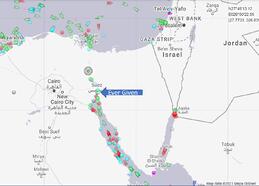A (Suez) crisis of supply chain visibility
A Suez crisis of supply chain is about to hit retail, after an enormous container ship got stuck in the canal. Sadly, there is little visibility as to what is stuck and where.

As if retailers didn’t have enough to worry about with Covid-19 impacting the supply chain, there is now a serious disruption to shipping that looks set to make life much more difficult.
On the 23rd of March, the Ever Given – one of the largest container ships in the world (1300 feet long and 656 feet wide) – ran aground in the Suez Canal, rendering the canal impassable to all traffic. There are reports that the salvage operation could take weeks.
While the Ever Given itself is carrying up to 20,000 containers, the issue is much larger and widespread as shipping traffic builds up in the Red Sea and North of Port Said (see image below from www.marinetraffic.com).

An estimated $9.6 billion of trade goes through Suez each day, some of which is consumer products manufactured in China and other Asian countries destined for retailers in Europe. But what – exactly – are these products? And do retailers yet know how their supplies are likely to be impacted? At this stage probably not.
Orders for products coming from Asia are made weeks and months in advance but understanding of where specific orders are in the extended supply chain is rare. The impact will not be felt immediately but, given the uncertainty over how long the blockage will take to remove, it is difficult plan or project forward as to the potential impact.
Visibility is key
I have previously discussed visibility over the past few years – including the concept of supply chain control towers. Much of this has been focused on visibility of internal assets and operations and the need to eliminate data silos that constrain operations. But given the vast complexity and length of global supply chains the need for extended visibility really comes into focus.
Imagine having the ability to see where all your orders are now – but also being able to project the impact on your supply chain several weeks from now. This would mean you could undertake analysis of multiple what-if scenarios to understand the impact, depending on how long the problem lasts. You could evaluate the cost-versus-benefits of alternative routes for different types of merchandise. This requires elimination of not just internal silos but the ability to reach outside to incorporate data from your suppliers and their shipping partners into the picture.

Software AG is unique in being able to provide hybrid integration that encompasses, in a single platform, the ability to manage APIs, integrate applications, data and IoT devices. But also, critically, in this scenario you can leverage APIs and B2B integration technology to incorporate the external information needed to provide a complete picture.
When it comes to a crisis, only once you have the complete picture can you carry out detailed scenario planning to determine what actions need to be taken now.
Find out how you can leverage technology to deliver visibility of your extended supply chain and help you deliver rapid results by clicking below.